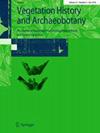青铜时代Kaymakçı(安纳托利亚西部)古植物遗骸的稳定碳同位素(δ13C)分析,以研究作物管理
IF 1.9
2区 地球科学
Q1 PALEONTOLOGY
引用次数: 0
摘要
本文章由计算机程序翻译,如有差异,请以英文原文为准。
Stable carbon isotope (δ13C) analysis of archaeobotanical remains from Bronze Age Kaymakçı (western Anatolia) to investigate crop management
求助全文
通过发布文献求助,成功后即可免费获取论文全文。
去求助
来源期刊
CiteScore
5.30
自引率
8.00%
发文量
32
审稿时长
>12 weeks
期刊介绍:
Vegetation History and Archaeobotany publishes research papers, review articles and short contributions of high quality from Europe, the Americas and other parts of the world. It covers the entire field of vegetation history – mainly the development of flora and vegetation during the Holocene (but also from the Pleistocene), and including related subjects such as palaeoecology. Of special interest is the human impact upon the natural environment in prehistoric and medieval times; this is reflected in pollen diagrams as well as in plant macroremains from archaeological contexts.

 求助内容:
求助内容: 应助结果提醒方式:
应助结果提醒方式:


